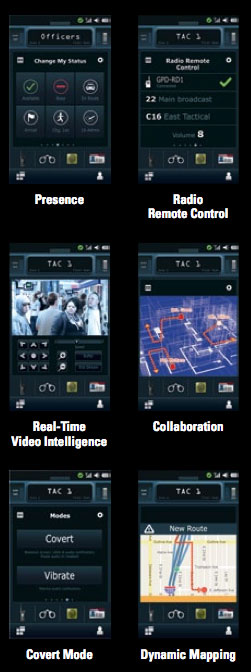In February of 2012, Motorola Solutions introduced the LEX 700 Mission Critical Handheld. It's hardly bigger than a consumer smartphone but, as the name implies, it's an entirely different class of device, one that connects to public safety LTE broadband, is tough as nails, and was designed from the ground up to give public safety personnel a tool they can count on in the thick of things.

First, let's be clear about the nature of the Motorola LEX 700. This is not just a ruggedized smartphone to replace an iPhone or Android device while on the job. While it can provide most standard smartphone functionality (it's initially based on Windows Handheld Embedded 6.5.3, formerly known as Windows Mobile 6.5.3), the emphasis here is on providing critical information in the field, monitoring the environment, gathering information, and just generally be more aware. Which requires hardware and software that transcends what's available in consumer phones.
Considering its ambitious goals, the LEX 700 is remarkably small, light, and handy. It measures just 5.3 x 2.8 x 0.7 inches and weighs 8.2 ounces with the standard 1x battery. That's a bit larger and heavier than the iPhone class of smartphones, but much smaller and lighter than most ruggedized phone/handheld computer combination devices. That's especially impressive given the LEX 700's large 4-inch display with 480 x 800 WVGA resolution (which is less than the iPhone 4's 640 x 960 "retina" display resolution, but plenty high enough). And unlike almost all Windows Mobile/Embedded Handheld devices, the LEX 700 has a modern capacitive touch screen.
Under the hood you find a 1GHz dual core Texas Instruments OMAP 4430 processor with integrated PowerVR SGX540 graphics acceleration, the same setup that powers the Kindle Fire, the Nook, and Motorola's Droid RAZR. There's a gig of RAM and 8GB of storage, and that's expandable by up to 32GB via microSD card. There's a micro-B USB 2.0 port, a standard 3.5mm audio jack, and an accessory/charging surface mount port. The auto-focus camera has smartphone-class 8 megapixel resolution and an LED flash. It can also do 30 fps video, but only in 720 x 480 pixel D1 resolution, and not full 720p or 1080p HD video like many smartphones now can do. Still, that's better than the cameras in almost all rugged devices on the market.
On the wireless and communications side the LEX 700 shines. Since public safety agencies rely on voice communications, the LEX 700 offers a multitude of voice technologies, including VoIP support for secure calls over a Mobile VPN, ASTRO 25 radio network connectivity via a
LTE-P25 gateway, a dedicated Push-to-Talk button, and dual noise canceling microphones. All, of course, on top of standard voice connectivity over cellular networks. There's also dual band 802.11a/b/g/n WiFi as well as Bluetooth 2.0 + EDR (2.1 would be better for extra security) and Mission Critical Wireless with secure touch pairing with P25 radios.
On the ruggedness side of things, sealing is at the IP54 level, where the "5" means protection against dust, and the "4" means protection against water spray from all direction, but each with limited ingress permitted, so we're not talking fully dust and waterproof here. The LEX 700 can handle 4-foot drops, and the -22° to 131° Fahrenheit operating temperature range is wide enough for deployment almost anywhere. The display is damage-protected via alkali-aluminosilicate glass, which I believe is similar to Corning's Gorilla glass. Moto doesn't spec what the LEX 700 is made of, but it looks rather tough and well-protected.
 Not being law enforcement officers and not having had any hands-on with the LEX 700, we cannot comment on how well it all works. The device is different insofar as it uses neither a keypad nor a stylus and is operated entirely via capacitive touch and a small number of physical controls (the PTT button, home, phone, back, etc.). While Windows Embedded Handheld 6.5.3 supports capacitive touch, it was not designed for it, and so we assume that much of the LEX 700 functionality is custom-designed for this device and its intended application. The image to the right shows screen captures of some of them, and it's easy to see that having all that information in the palm of an officer's or first responder's hand can be invaluable.
Not being law enforcement officers and not having had any hands-on with the LEX 700, we cannot comment on how well it all works. The device is different insofar as it uses neither a keypad nor a stylus and is operated entirely via capacitive touch and a small number of physical controls (the PTT button, home, phone, back, etc.). While Windows Embedded Handheld 6.5.3 supports capacitive touch, it was not designed for it, and so we assume that much of the LEX 700 functionality is custom-designed for this device and its intended application. The image to the right shows screen captures of some of them, and it's easy to see that having all that information in the palm of an officer's or first responder's hand can be invaluable.
What's interesting is that Motorola mentions planned upgradeability to Android 4.0. Android, of course, is designed from scratch for capacitive touch operation, and it will be interesting to see whether the LEX 700 develops towards Android, or stays within the Windows Embedded Handheld realm.
Motorola also stresses its many years of experience with large-scale device deployments and its device management expertise, claiming that it reduces annual support costs by over 80% compared to deployments without device management. Certainly a point to consider.
Those interested in the Motorola LEX 700 should take advantage of Motorola's very comprehensive documentation, product tours, video and brochures (see spec sidebar links).



